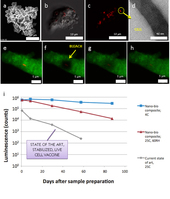Highlight
Nano-engineered, Ultra Stable, Live Cell Vaccines Against Tuberculosis
Achievement/Results
Tuberculosis, a deadly pathogen that infects a third of the world’s population, is on the rise and the increased prevalence of drug resistant strains makes treatment very challenging. The clear way forward is in prevention via vaccination; however the current vaccine, Mycobacterium bovis BCG, is handicapped by its highly variable efficacy, use of needles, difficulty in transportation and its requirement for constant refrigeration. State of the art live-cell vaccine candidates that seek to overcome these issues remain susceptible to ambient temperatures and improvements in live-cell formulations have been modest. In order to address the increasing prevalence of tuberculosis, alternative vaccine candidates must therefore be developed. They must be scalable; easily handled, transported and distributed; active as vaccines; and, most critically, they must maintain cell viability and bioactivity in accelerated conditions of temperature and humidity.
To address these conditions, Patrick Johnson, an INCBN IGERT Trainee, has developed an immunologically active formulation that offers high tolerance to environmental stress and long shelf life for live-cell vaccines. Silica/lipid encapsulation of living cells via Cell Directed Assembly (CDA) results in an ordered extracellular matrix-like structure surrounding living cells. This process was adapted to a commercial spray drying apparatus (Buchi, Switzerland) resulting in the first demonstration of high-volume production of nano-ordered structures within this class of nanomaterials. The macrostructure of individual particles was observed with scanning electron microscopy (SEM) and confocal imaging, which reveals discrete, flowable particles. The lipid-templated nanostructure within the particles was characterized by transmission electron microscopy (TEM) and found to be well ordered and occurring throughout the entire particle. The state of the nanostructure-supporting lipid was analyzed with Fluorescence Recovery After Photobleaching (FRAP) on a confocal microscope and found to exhibit biologically relevant fluidity with a diffusion coefficient of ~10-10cm2/s and is comparable to findings for long chain lipid in unilamellar vesicles. This fluid interface between the cell and the matrix is hypothesized to maintain the environment necessary to support high viability within the dried material.
The macrostructure as determined with SEM and confocal microscopy, as well as the nanostructure observed with TEM and FRAP, are consistent with previous findings in CDA and were important to verify before investigating the material ability to withstand thermal stresses. The viability of encapsulated cells was determined using an ATP assay (Bactiterglo, Promega), which releases a luminescent derivate of luciferin in the presence of ATP. The assay has a linear relationship with colony forming units in a control experiment using E. coli and is effective when used with dry powders. Spray dried samples incorporating E. coli were aged under refrigerated and accelerated conditions and analyzed using the above mentioned ATP assay and compared to the state of the art, stabilized vaccine. Matrix encapsulated cells demonstrate greater than 100-fold viability preservation over current state of the art. The sol-gel-based encapsulation of a live-cell vaccines model is scalable, easily handled, and highly tolerant to environmental stresses. These features offer the potential to revolutionize the ability to immunize the world against tuberculosis with a stabilized, live-cell vaccine.
Address Goals
Primary: This research project offers important advancements that are consistent with NSF strategic goals through the unique union of biological species with solid-state materials. This new area of bio-nano composite materials offers functional nano-engineered structures that may be applicable to a wide range of experimental thrusts. Bio-nano composites are formed via lipid templating of silica precursors and result in highly ordered films that exhibit a fluid lipid interface. This fluid lipid environment is hypothesized to provide the bio-interface necessary to harbor live cells within the encapsulating nanostructure. Although these materials are feature-rich, previous preparation methods yielded thin films on microscope cover slips and were not scalable. The main objective is to create stabilized vaccines against tuberculosis, using lipid templated silica nanostructures and required vaccine-relevant quantities of material.
To address this requirement, the techniques in material chemistry necessary to create functional bio-nano composites to a scalable spray drying process were applied, and succeeded in creating a flowable, powdered form of the bio-nano composite material. This is the first demonstration of spray drying silica-lipid material and preparations including living cells yield viable powders that are over 100 fold more resistant to thermal stresses under accelerated aging as compared to current state of the art. This may be a powerful tool in the mission to eradicate tuberculosis, but is not limited to this field of research. These methods offer the potential for extension into other live-cell vaccines or the development of thermo-tolerant biological carriers for DNA or proteins. This highly interdisciplinary field has many opportunities to address problems in global health as expressed in the NSF mission statements.
Secondary: Although research and discovery are the primary goals of this project, learning is an important byproduct due to the encouraged collaboration of the dual mentor environment, a relationship between material engineering and pharmaceutical science. This rich interdisciplinary environment offers important learning opportunities for graduate students in training and reemphasizes the ever increasing interdisciplinary of modern science research.






